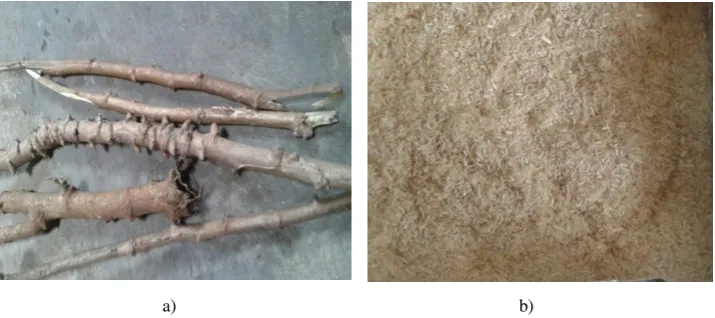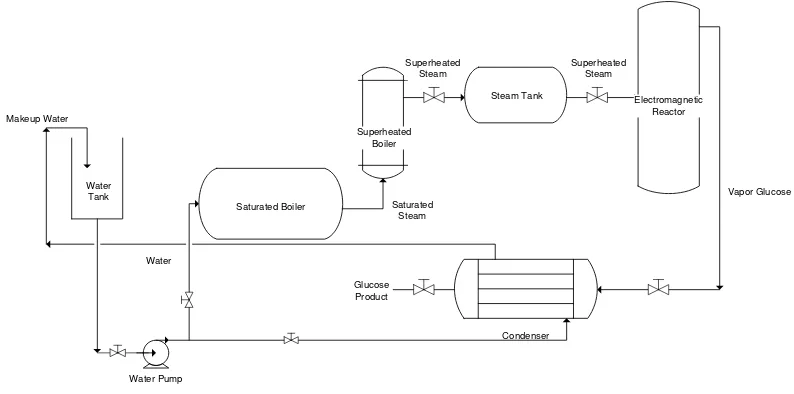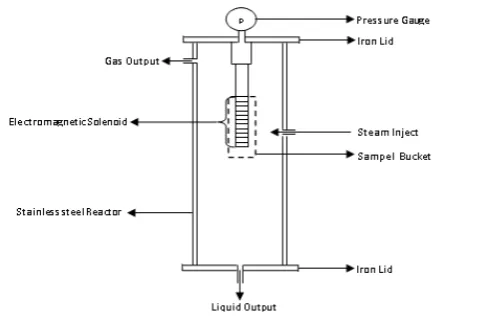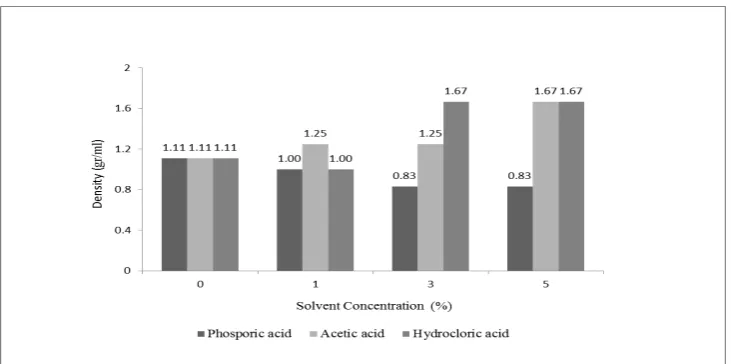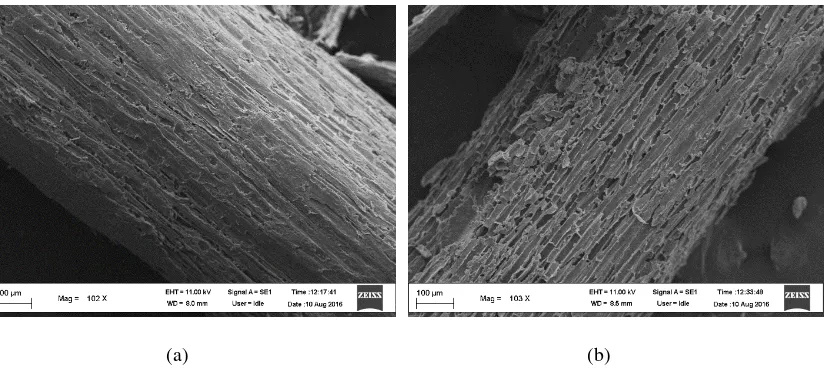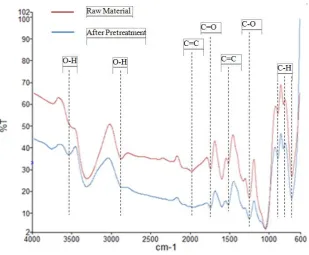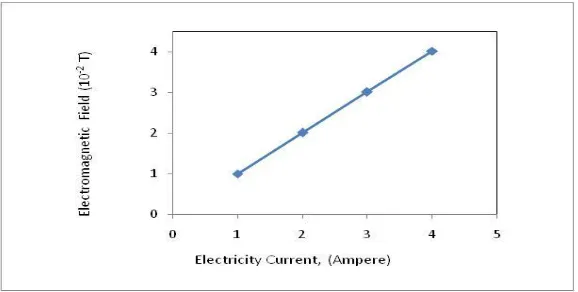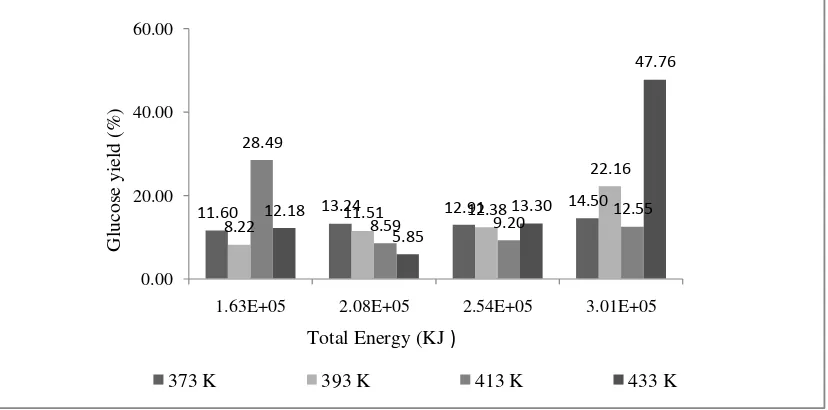Assisted of electromagnetic fields in glucose production from cassava
stems
To cite this article: Lia Lismeri et al 2018 IOP Conf. Ser.: Earth Environ. Sci.141 012017
Assisted of electromagnetic fields in glucose production from
cassava stems
Lia Lismeri
1,3, Sri Haryati
2, M Djoni Bustan
2, Yuli Darni
1,3.
1
Department of Chemical Engineering, Lampung University, Bandar Lampung-Lampung, Indonesia 2
Department of Chemical Engineering, Sriwijaya University, Palembang, South Sumatera, Indonesia 3
Tropical Biomass R & D Centers of Lampung University, Bandar Lampung, Lampung, Indonesia *Corresponding author: E-mail: [email protected]
Abstract. Decrease in fossil fuel reserves that led to high price has become major problem in manycountries around the world. To acquire the sustainability of energy reserves, the renewable energies obtained from plant biomass will therefore have to play an increasing role in fulfilling energy demand throughout the century. Renewable energy source must be explored by innovative techniques which is safe to the environment and low in energy consumptions. This research conducted to produce glucosefrom cassava stems assisted by electromagnetic field inductions process. The parameters used in this research were pretreatment solvent, concentration, temperature and electrical currents. The electromagnetic field inductions could be applied to increase glucose productivity with the maximum yield of glucose was 47.43%.
Keywords:cassava stems, electrical current, electromagnetic fields and glucose.
1. Introduction
The energy crisis during the 21st century is indicated by the increasing prices of fossil and has been faced by all countries on the world. The fossil fuel is not renewable and the availability isdecreasing every year. Production of crude oil comes down over the year, from the present 25 billion barrels to about 5 billion barrels in 2050 [1]. National energy consumption in 2000-2011 was dominated by fuel (fuel oil). The projection gasoline consumption in 2030 is not expected changed a lot which is about 45.4%. Nonetheless, fuel consumption in 2030 will rise by 154% compared to the consumption in 2011 to around 107 million kl/year. In the 2030 national fuel consumption was amounted to 55.64% and met by imports. Production of domestic crude oil supply for the year is estimated at 10 % and the rest is met by imports. From that situation this makes it is imperative to develop new economical and energy-efficient process for the fuel Production from renewable resources. The potential renewable energy source that can substitute fossil energy is biomass [2]. Our government has made a policy to support efforts in the use of alternative energy sources such as biofuels which is a biomass-based energy that is considered reliable in terms of technical, economic, environmental, and renewable fuels.
Cellulose, hemicellulose, and lignin are the major component of lignocellulose. In nature, cellulose is usually associated with other polysaccharides such as xylan and lignin [4]. Cellulose is the skeletal basis of plant cell walls. Lignin is a highly cross-linked phenylpropylene polymer [5]. Lignin plays an important role in cell wall structure as a pretreatment bonding agent among plant cells. There are chemical bonds between lignin and hemicellulose and even cellulose [6]. As cell walls in biomass feedstockdiffer in structure and chemical composition, one pretreatment method will not necessarily fit all applications. Therefore, developing a pretreatment technology that is effective over a wide range of biomass materials is important.Many pretreatment methods have been reported and several detailed review papers have been published [7]. An ideal pretreatment should be cheap, as much as removal lignin, effective for various lignocellulosic substrates, minimal glucan loss and inhibitorgeneration,safe to environment and low in energy consumptions. According to [8], dilute sulfuric acid pretreatment with microwave-assisted heating can save amount of energy in disruption of sugarcane bagasse lignocellulose. The combination of ionic liquid and microwave heating also done [9]. Consequently, there is currently no single pretreatment technology that is potentially acceptable for the multiple biomass conversion.The pretreatment process indicates positive impact on the cellulose hydrolysis and consequently the glucose yields. The purpose of the pretreatment is to separate lignin and hemicelluloses from cellulose, reduce cellulose crystallinityand increase the porosity of the lignocellulose so that cellulose hydrolysis can be improved significantly [10].
Hydrolyzing the cellulose into glucose is performed by using specific enzyme in certain conditions such as temperature, the concentration of enzyme, the quantity of cellulose, pH and time so Acid hydrolysis occurs rapidly and is more cost effective than enzymatic hydrolysis [11].Direct hydrolysis by using ultra high temperature and pressure steam explosion were very effective [12]. The electromagnetic field application for producing bio-gasoline from CPO has been done and shows positive impact on the bio-gasoline properties [13]. Based on the previous study, came the idea to conduct research related to the effect of the dilute acid, electromagnetic and steam combination reaction in the pretreatment and hydrolysis of cassava stems.
2. Materials and Methods
To convert cassava stems into glucose, there are two main step processwere done in this research: Swelling of cassava stemsby using acid solvent as lignocellulosepretreatment and hydrolysis of cellulose in electromagnetic reactor. Cassava stems used in this research was taken from PT. Budi Acid Jaya in Central Lampung, Lampung, Indonesia. The chemical used in this research were: phosphoric acid (H3PO4), acetic acid (CH3COOH), hydrochloric acid (HCl), hypochlorous acid (HOCl), distilled water and steam.
2.1 Cassava Stems Preparation.
a) b)
Figure 1 .Cassava stems : (a) Raw material, (b) after size reduction
2.2 Solvent Preparation.
Phosphoric acid, acetic acid, and hydrochloric acid were the solvent used in the pretreatment step, the concentration of solvent used in this research were 0%, 1%, 3 %, and 5%, respectively. Hydrolysis of cellulose into glucose occurred in a set of electromagnetic reactor equipped with boiler, preheater, steam drum and condenser shown in figure 2. 3%hypochlorous acid wasused in this step, made from calcium hypochlorite and water based on reaction below:
Ca (ClO)2(s)+ 2 H2O(l) 2 HOCl(l)+ Ca(OH)2(s)
Calcium hypochlorite Water Hypochlorous acid calcium hydroxide
Water Pump
Figure 2. Schematic design of glucose production from cassava stems
.2.3 Acid Pretreatment
Determinations of solvent, concentration, time and temperature process are the main variables in pretreatment. In this step, the phosphoric acid (H3PO4), acetic acid (CH3COOH) and hydrochloric acid (HCl) were used as solvent. The acid pretreatment took placein the reflux apparatus. A total of 50 grams of cassava stem heated in reflux with distilled water and acid solution. The ratio of the samplesand cooking liquor was 1: 6 gr/ml. Variable concentrations of solvents were 1, 3, and 5%. After swelling wasdone for 1 hour and at 90 °C, the samplewas separated from the liquid cookers, filtered, washed with distilled water to neutral pH, and dried using an oven at 80°C. To identify the effect of swelling process to the samples several chemical and physical analysis done such as density, composition, SEM and FTIR test.
2.4 Hydrolysis
Figure 3. Electromagnetic Reactor Design
2.5 Reduction sugar analysis
Concentration ofglucose was predictedby JENWAY 6305 spectrophotometry. First step to do was making glucose standard solution which material analysis composed of glucose solution, Nelson reagent, distilled water, and Arsenic reagent. Glucose standard solution made of 10 mg of pure glucose dissolved in 100 ml distilled water. Then, glucose solution was taken as 0-4 ml in test tube. Each sample is was added with distilled wateruntil 10 ml. Add solution with 1 ml Nelson reagent heated in boiling water during 20 minute and cooled till room temperature. Mix each solution with 1 ml Arsenic reagent and put it to spectrophotometry cuvette to test glucose content.Perform these treatments on all samples.
2.6 Cellulose analysis
The method to measure the content of cellulose and lignin based Datta method proposed by Chesson (1981). 1 gr of dry sample (weight a) was added to 150 mL H2O or alcohol-benzene and refluxed at 100°C with a water bath for 1 hour. The resultswere filtered, the residuewas washed with 300 mL of hot water. The residue then dried in an oven until constant in weight (weight b). Residues and 150 mL of 1 N H2SO4, then refluxed with a water bath for 1 hour at a 100° C. The results were filtered and neutral (300 mL) and dried to constant weight(weight c). Dried residue was added with 10 mL of 72% H2SO4 and soaked at room temperature for 4 hours. Add 150 mL of 1 N H2SO4 and refluxed at 100°C with a water bath for 1 hour in a cooler.Residuewas filtered and washed with H2O until neutral (400 mL). Then the residue was heated in an oven with a temperature of 105°C until constant weight and weighed (weight d). Calculation of cellulose content using the following formula:
3. Results and Discussions
Cassava stems as lignocellulosematerial used in this study was analyzed and has a composition such as Cellulose 39.29 %, Hemicellulose 24.35% and Lignin 13.42%, respectively.
a. Effect of variation and concentration of solvent to the lignocellulose density of pretreatment process.
The pretreatment purpose is to reduce lignocellulose material recalcitrance by altering cell wall structural. By this process, the polysaccharide fractions (mainly cellulose) locked in the intricacy of plant cell walls will be more accessible and improve the sugar yields. The pretreatment of lignocelluloses impactsthe recalcitrance of biomass including the resulting biomass constituents, cellulose crystallinityand ultrastructure, lignin/hemicellulose structures, cellulose degree of polymerization, and accessibility.Hemicellulose fills the gap between lignin and cellulose. The solubility of hemicellulosesis directly linked increase in biomass porosity [14].In this study, pretreatment by using acid solvent in various concentrations as swelling process was indicated by the change in pore volume of biomass. The change of biomass pore volume means the change in its density. The density of pretreatment cassava stems and raw material show the various change in each conditionsand shown in figure 4.
Figure 4.Effect of variation and concentration of solvent to cassava stems density.
At this swelling process, variation and concentrations solvents were used to determine the best density of the sample. The best density is the smallest density value, because the swelling goal is to break the structure of cellulose from hemicellulose and lignin bonding, damage the crystal structure of cellulose and increase the volume of material. By the swelling, cellulose volume will be greater than the initial volume prior to thetreatment. Dividing the mass of the lignocellulose to obtain the volume after treatment gives the density value of sample.
concluded that the best solvent for swelling step is phosphoric acid with the concentration of 3%, the smallest result of the density value achieve in this step is 0.833 g/ml.
b. SEM (Scanning Electron Microscopy) images
SEM analysis was conducted to determine the effect of acid pretreatment on the material structure. The SEM images presented the surface of raw and treated cassavastems in best conditions of the step. The SEM images clearly show that raw material of cassava stemshas smooth and continuous surface. Figure 5 (a) Shows basic and compact of fiber surface structure. By swelling in 3% H3PO4 for 1 hours and 90°C, the gradual breakdown of fiber cell wall and the reduction in fiber dimensions were apparent on the surface of solid product. Under this condition, the high levels of residual lignin an a little number of hemicellulose removalwas observed by structural rapture and pores which present at the surface [15]. The accessibility of cellulose fibrils to separate was enhanced by the pretreatment of lignocellulose biomass. These results indicate that dilute acid pretreatment induces severe morphological changes in the plant cell walls studies and are in general agreement with significant lignin removal observed.
-
(a) (b)
Figure 5. SEM images of raw (a) and treated (b) cassava stems at 3% H3PO4
c. FT-IR analysis of functional group of treated cassava stems
11.60
1 ampere 2 ampere 3 ampere 4 ampere
Temperature(°C) cassava stems, corresponding to the degradation of cellulose in acid pretreatment.
Figure 6. FT-IR spectra of raw and solid products pretreated in 3% of Phosphoric acid
d. Effect of Temperature to Glucose Yield at Different Electrical Current
The glucose yield was increasing when the temperature rises as shown in figure 7. The best value of the glucose yield was 47.76 % in 160 °C with4 ampere electrical current.
This means that in higher temperature, the molecules react with enough force to create a reaction, based on collision theory. The higher temperature produces the higher energy to cause the molecules to collide, so that the activation energy which is the energy kinetic required for the collision to yield a successful reaction become minimum. By the kinetic theory, increasing the temperature makes the molecules accelerate thus there will be more chance of a collision. Since the molecules will move faster than average at high temperatures the amount of energy generated on impact is more than enough to sustain a successful product. On the contrary, if the reaction occurs at low temperatures, there will be less chance for the molecules to collide due to decreased acceleration.
e. Effect of Electromagnetic Field to Glucose Yield.
The electromagnetic field generated by solenoids which was electrified
[17]
. A solenoid coil made of conductor wire that is wrapped tightly. The strength of the magnetic field generated from the solenoid is affected by strong currents that flow in the solenoid, the number of windings and length of wire solenoids. When electrical current transmitted to the solenoids, magnetic fields aregenerated and give an induction to the spin electron of the molecules[18].The higher the electrical current transmitted, the higherinduction or electromagnetic fields were produced as shown in figure 8.The electromagnetic field gives impact to the yield of glucose as shown in the figure 9.At higher electromagnetic field, theyieldincreased to the value 47.76 % with 4 ampereelectrical current. There is a significant impact resulting from external magnetic fields on the reaction. Under certain conditions, the magnetic field that changes the rate constant of reactions involving radicals can be interrupted its steady state and move toother system conditions with differentinitial conditions [19].The atomic particles of the molecules which are affected by group magnetic fields will become more active and in the same direction neatly correspond to the magnetic field direction. Molecular events increase due to the magnetic field will cause the molecular group becomes fragmented.The induction of electromagnetic field causes the polarization effect of the molecule. The polarization will arrange the spin of unpairs electron from radical (intermediate) to excite to the molecules orbital and form the product.The Zeeman interaction between the unpaired electron spins on each radical and the magnetic field obviously plays an essential role in the product formation [20]
.
11.60 13.24 12.91 14.50
Figure 9. Effect of Electromagnetic Field to GlucoseYield
f. Effect of Energy Supply to Glucose Yield at Different Temperature.
The sum of solventand steam energycalculated as energy supply to the hydrolysis reaction. Energy supply gives the significant effect to percent yield of glucose as shown in figure 10.
Figure 10. Effect of Energy Supply to Glucose Yield
4. Conclusions
Based on this research, it can be concluded that the optimum result of acid pretreatment process was using3% phosphoric acid with 0.833 gr/ml density value. The highest glucose yield was 47.76% occuredat temperature 160°C, 4 x 10-2 T electromagnetic field in 50 minutes reaction time.
5. Acknowledgement
On this occasion, the authors would like to acknowledge my advisor at Chemical Engineering Graduate ProgramSriwijayaUniversity, for their enlightening suggestions, guidance, and kind encouragement throughout this study. The authors also would like acknowledge all people who have helped in completion of this research.
6.
Reference
[1] Colin J. Campbell and Jean H. Laherrère. 1998. The End of Cheap Oil. Scientific American [2] George W,. 2006. An overview of aqueos-phase catalytic processes for production of hydrogen
and alkanes in a biorefinery. Elsevier.
[3] DepartemenPertanian republic Indonesia. 2009. Basis Data StatistikPertanian http://database.deptan.go.id/bdsp/index.asp.
[4] Hanwu Lei, Iwonacybulska, James julson. 2013. Hydrothermal Pretreatment of lignocellulosic Biomass and Kinetics. Journal of sustainable bioenergy Systems, page 250-259
[5] Agbor VB, Cicek N, Sparling R, Berlin A, Levin DB. 2011. Biomass pretreatment: fundamentals toward application. Biotechnol Adv. 2011;29(6):675–685. doi: 10.1016/j.biotechadv.2011.05.005.
[6] Harmsen P. 2010. Literature review of physical and chemical pretreatment processes for lignocellulosic biomass. Biosynergy.
[7] Kumar, R., Wyman, C.E., 2013. Physical and chemical features of pretreated biomass that influence macro-/micro-accessibility and biological processing. In: Wyman, C.E. (Ed.), Aqueous Pretreatment of Plant Biomass for Biological and Chemical Conversion to Fuels and Chemicals. John Wiley & Sons, pp. 281–310.
[8] Wei-Hsin Chen. 2011. Disruption of sugarcane Bagasse lignocellulosic structure by means of dilute sulfuric acid pretreatment with microwave-assisted heating. Elsevier.
[9] DU jun. 2010.Fast pyrolysis of biomass for bio-oil with ionic liquid and microwave irradiation. Journal of fuel and technology, 38(5) : 554-559.
downstream biocatalytic hydrolysis of various lignocellulosicmaterialsBiotechnol Biofuels (2015) 8:228 DOI 10.1186/s13068-015-0419-4
[16] Yang H, Yan R, Chen H, Lee DH, Zheng C. 2007.Characteristics of hemicellulose,cellulose and lignin pyrolysis. Fuel; 86: 1781-1788.
[17] Gillesberg, Tom. 2009. 21st Century Science &Technology : Flu Dynamics in the Noösphere, 22-33.
[18] Cullity, B. D., and Graham, C. D., 2009. Introduction to Magnetic Materials.2nd Edition.A john Wiley & Sons, Inc.
[19] Kipriyanov, A.A., and Purtov, P.A. 2012. Prediction of a Strong of a Weak Magnetic Field on Diffusion Assisted Reaction in Non Equilibrium Condition. Bull. Korean Chem. Soc. Vol 33, No. 3, pp. 1009-1014.
